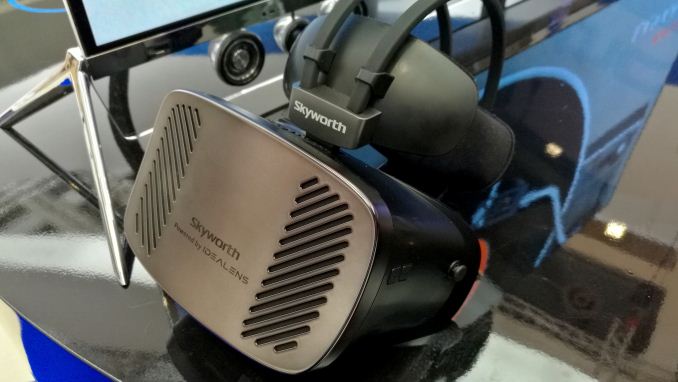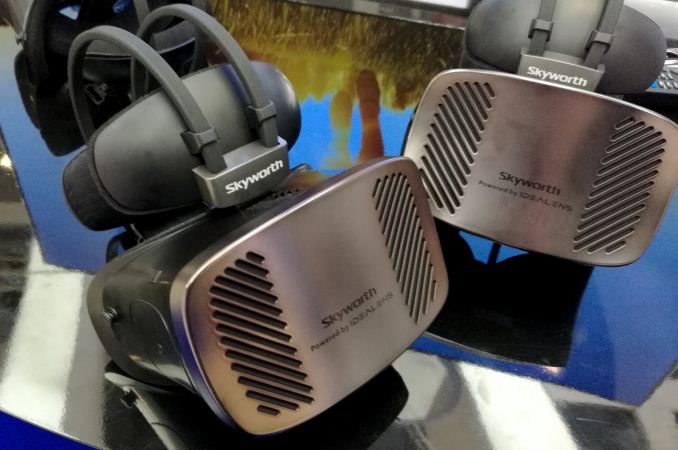IFA 2016: Examining the Malaise of Bargain Basement Virtual Reality
by Dr. Ian Cutress on September 9, 2016 9:00 AM ESTGoing Above $100: The Skyworth AIO-VR
In the last few minutes of the show I was steered towards the Skyworth booth in a different hall and told to go see their all-in-one headset. I was told that in comparison to the others, the Skyworth offering might be a substantial substitute above the cheap VR on display. The problem is always the cost, which we’ll get onto in a minute. The Skyworth VR setup was on display to test, however there were no specifications on display, and we weren’t allowed to take a picture of the image on the demonstrator’s phone that had all the hardware listed, but I was able to memorize a few key points.
It’s worth saying that the Skyworth AIO-VR was slightly bulkier than the other headsets, if only because the mechanism to mount it on your head was a plastic part of the design, aimed at balancing the weight a little but also securing it more firmly with padded guards. The outside was still plastic, however with a brushed metal look, and slightly more attention to detail.
The units were up and powered, and after putting it on I could tell the interface was smooth. Don’t get me wrong, the pixels were still quite obvious, but moving my head showed a high frame rate display better than the 30/60 Hz offerings of the cheaper implementations.
As far as I could jot down in a reasonable time, the headset uses an Exynos 7420, which is a 4x4 big.Little design using quad ARM Cortex A57 at 2.1 GHz and quad ARM Cortex A53 cores at 1.5 GHz on a 14nm process. The 7420 also uses Mali-T760MP8 graphics, at 772 MHz, which is good for 210 GFLOPs, and is paired with dual-channel (2x32-bit) LPDDR4. This SoC was powering dual 1080x1200 displays inside, which is a formidable number of pixels, and I saw that we’re looking at a 3800 mAh battery. Other specifications I can’t remember, though one would assume a 4GB/64GB arrangement for memory and storage if this was a smartphone.
So here’s the thing: the Skyworth headset is essentially a smartphone under the hood that you can’t take out. So what makes it better than a Samsung VR headset where the smartphone can be attached / detatched? One would assume it’s a price thing, and we were told the price for the headset could be $400 to $800. I remarked that it was a pretty large range, but was told that the Skyworth headset is still a work in progress, with exact specifications to be decided later. If it was $400, it might be more palatable, but for $800 then it might be easier to go the smartphone route.
The Problem with Low Cost VR
This brings us around to the problem with VR right now. Everyone wants in on the bandwagon, and in a keynote at the event it was pointed out that in order for triple-A style games and film studios to start making content in these new formats, there needs to be more potential sales out there. Current estimates put 500k headsets in the market (of varying degrees of power) with another 2.7 million by the end of 2017. No game studio or film studio, working on the next FPS or Avatar, will make a massive piece of content for only 3.2 million people – it needs to be in the hands of tens of millions to even start to make sense, and we won’t be at that point for a number of years.
All that being said, you have a choice – investing in a premium VR headset to be able to experience the best will cost $700+, in terms of the headset itself plus any extra hardware you need to power it. The easiest way to enter the VR space with some clout is the smartphone or all-in-one route, but that is still a hefty cost. Then there is a large, long gap to the segment of very basic all-in-one virtual reality headsets as shown at IFA this year.
For $100, or the rough price of the Samsung headset without any internal hardware, you get a basic quad-core Rockchip design with limited functionality. I’m half inclined to suggest that a bucket be provided as well, just in case nausea takes over. But it shows what a state VR is in, when the hardware is still so expensive. In order to get a base experience that can truly be called VR, such as with the Skyworth headset, it might be as much as a high-end smartphone anyway. For mass market adoption, the cost to enter has to be low, but not so low we’re scraping the barrel for basic frame rates.
Picture Galleries















































59 Comments
View All Comments
msweeney - Friday, September 9, 2016 - link
This is an important observation, thank you.I personally decided to take the plunge on a Vive+GTX 1080 and my cost all in was just less than $1600. Granted my base system is an older i5-2500K but it seems to work well enough with the incredibly potent Pascal added to the mix.
I found my GTX 970 to be respectable but clearly lacking in terms of VR capabilities, but others might not have the same needs as I do.
msweeney - Friday, September 9, 2016 - link
Oh I forgot to add this for those who do happen to be on the fence:I have never been a religious person, but I will say that Elite Dangerous on a VIVE/1080 is positively *divine*.
Mugur - Monday, September 12, 2016 - link
What's the status for the Vive issues in ED? I've contemplating myself buying a headset for Elite next year...Badelhas - Monday, September 12, 2016 - link
I have a 1070 and the Vive. Installed that game but haven't tried it yet. Is it that good?!Cheers
xthetenth - Friday, September 9, 2016 - link
Being a geek is a lifestyle thing, not an income bracket.mkozakewich - Monday, September 12, 2016 - link
Also, not usually about having gaming computers, anecdotally speaking.(I personally spent $700 in 2010 to get a 6" netbook that fit in my pocket. That seems like the more usual kind of thing.)
theduckofdeath - Monday, September 12, 2016 - link
A PC that can power a Rift does not cost 2,000. A Radeon RX 480 is fully capable of the high frame rates VR requires, and a PC with that GPU is far less than a thousand <insert €,$ or £ here>.That's the price of a flagship phone, for a very capable PC.
edzieba - Friday, September 9, 2016 - link
The Chinese market already has plenty of clones available. For example, the Deepoon E2, which is a DK2 clone lacking position tracking (along with hacked 'compatibility' with the Oculus SDK 0.8 version). There was a lot of furore a few months back over Oculus adding a device check to their software, with the accusation flying that it was intended to lock out a Vive emulation layer, with little mention of the clones already on sale that declare compatibility with games using the Rift SDK without actually meeting the same quality standards (e.g. lack of position tracking, lack of low persistence, etc).hyno111 - Friday, September 9, 2016 - link
There are actually a lot more Chinese cheap vr clones, but none of them have hacked the Oculus SDK 1.0...as of yet. Some actually choose to be compatible with SteamVR, and also requires some messy hacking..edzieba - Saturday, September 10, 2016 - link
Oh certainly, that was just the one that immediately came to mind. Oculus' 'entitlement check' was easily bypassed, but it seems it is sufficient to do its job, making 'access' to content on Oculus Home not worth the sustained cat & mouse effort to work around for the cash-in clones, for the moment at least.